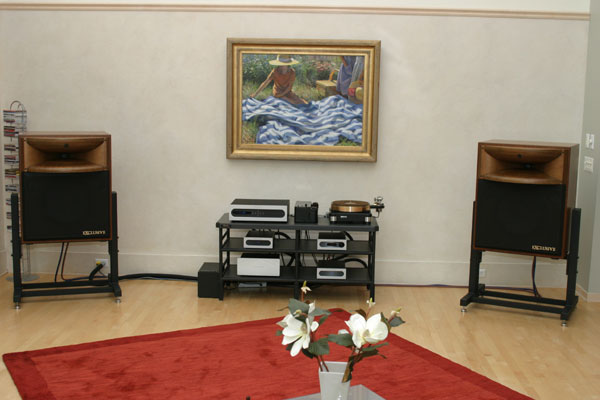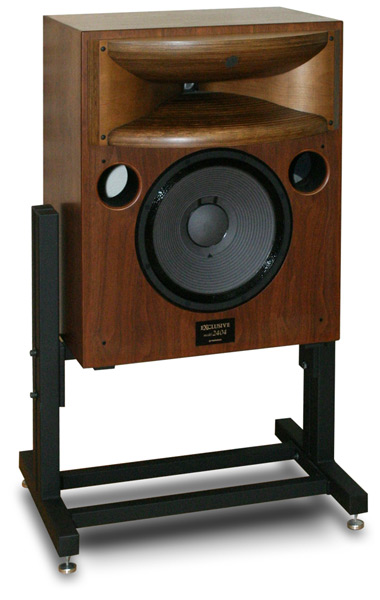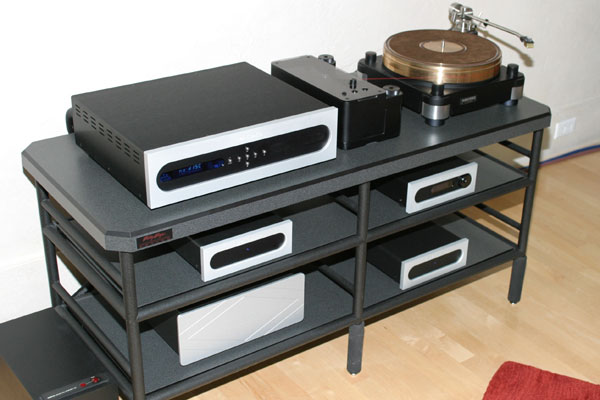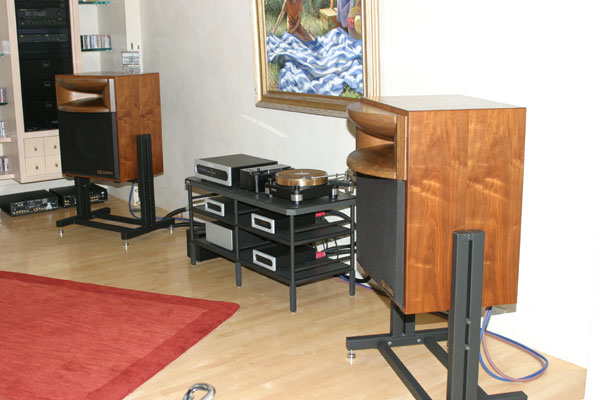![[SoundStage!]](../sslogo3.gif) Config.Sys Config.SysBack-Issue Article |
April 2007 Metro Chic
I read somewhere a few years ago an estimate of the number of audiophiles worldwide: one million. That's a lot of people -- more than those who had tickets for the first ten Super Bowls combined. However, consider the number of people in the world: more than six and a half billion, or 6500 million. Being one in 6500 makes each audiophile an infinitesimal minority; there are more birdwatchers or mountain climbers than audiophiles. When you factor in the permutations and combinations of equipment each audiophile uses, you realize that each of our systems is unique. Wilson Audio, for example, has made literally thousands of pairs of WATT/Puppy speakers, yet in the rural county in which I live, I would be surprised if there is another person with a pair of WATT/Puppy 8s in his listening room. For some more esoteric products, there might be one or two owners in all of North America. One of the stops I made on a trip "back home" -- Wisconsin -- last summer was at Bel Canto Design, which is located in a renovated commercial building in Minneapolis. There, John Stronczer showed me the products he was working on, including his e.One REF1000 mono amps and DAC2 digital-to-analog converter. However, the purpose of the visit to the Twin Cities was to hear John's system and write about it as the inaugural installment of "Config.Sys," our new column on interesting audio systems and the people who build them. This column takes its name from computer terminology. In the ancient days of personal computing, circa 1990 BW (before Windows), every owner knew about the config.sys file, which sat in the root directory of the C: drive. It's a text file in which device drivers are entered so they load when the computer boots up. Your Windows XP system still has a config.sys file, but you will likely never edit it (and shouldn't do so unless you know what you're doing). Windows does that work for you now. If only building an audio system happened as automatically. John Stronczer's house looks like one you'd see profiled in Architectural Digest. It's big and contemporary, possessing the sort of clean lines that impart a refined, polished look. It's located in a quiet residential neighborhood near Bel Canto's offices, which are in downtown Minneapolis near the Humphrey Metrodome. On mild summer days, John walks to work. I imagine he relishes every step. His listening room is down a long hall and off the kitchen, not sequestered from the rest of the house. As such, it makes no concessions to acoustic treatments or audiophile tweakery. There are no adsorbers or deflectors scattered around, no cables to trip over. A baby grand piano, which John's daughter Roxanne plays, sits off to one side. Wives everywhere would rejoice at seeing John's room. It's a true living room, a place where good company can share good music, not a reclusive listening lair.
A division of Pioneer, Technical Audio Devices was formed over 30 years ago with the stated goal of developing professional loudspeaker technology that bettered the famed work of both Altec and JBL. To ensure this, TAD hired Bart Locanthi of Altec and JBL to design its first drivers. TAD has been very successful in reaching this goal. Their speakers are used in some of the best and largest recording and audio-production facilities worldwide, including Radio France and numerous Japanese and large American recording studios. Skywalker Ranch designed their reference theater speaker system around TAD drivers. According to John, "Rumor has it that audio-quality fanatic Neal Young uses TAD horn systems for his reference monitors." Audiophiles came to know TAD a few years ago when the company began demonstrating its first consumer speaker at CES, the massive floorstanding Model 1. Stronczer's two-way ported TAD monitors use TAD-designed and -manufactured drivers that John calls "the best." The fabricated wooden horn is mated to a high-frequency compression driver, while the speaker's 15" woofer has a pleated surround for great excursion capabilities. TAD quotes the speaker's sensitivity as 95dB; its crossover point is 650Hz. Though the 2404s are discontinued, John estimates that a pair of them would cost $40,000 in today's market. They are by far the largest two-way monitors I've ever seen, measuring 26"W x 31 7/16H x 24 3/16D and weighing 200 pounds each. Minimonitors they ain't; gigantimonitors they are.
As expected, John's electronics are of his own creation. I found it interesting, though, that everything was new. In its past, Bel Canto created some well-regarded tube amps and preamps, some of which, I'm sure, would mate very well with John's speakers. But none was in use. Instead, John drove his speakers with a pair of e.One REF1000 monoblocks ($3990 per pair), which, according to our BHK Labs measurements, output almost 600 watts for 4-ohm loads and almost double that into the 8-ohm load of John's speakers. There was no preamp; instead, John was using a DAC3 digital-to-analog converter ($1995), which has a built-in analog-domain volume control. This received bits from a CD1 CD player ($4995) used as a transport. This configuration meant that John's vintage Micro-Seiki RX-1500 FG turntable with Fidelity Research stainless-steel tonearm and Decca London Jubilee cartridge were not in use. Speaker cables were Cardas Golden Presence in a shotgun configuration, while interconnects were Bel Canto's own. The power conditioner and power cords were from Shunyata Research, just what I was using at home. Even though John designs electronics, he beams when he talks about his TAD speakers. "The high-frequency impedance characteristic shows clearly that TAD horns do not suffer from the typical horn colorations caused by resonances from mouth reflection that show up as large ripples in the impedance response. There are a small series of very minor impedance ripples starting from the 300Hz resonance frequency of the driver and very little beyond until the first break-up mode of this 4" beryllium dome at around 18kHz (!)…. Horn-hating audiophiles hear no issues with this horn system." "Horn-hating audiophiles" -- that's me! I can never accept the obvious wrongs of horn-loaded speakers in favor of the one thing -- dynamics -- they do very right. But John is correct -- his big TAD monitors don't sound horny. They display none of the colorations I hear in other horn speakers, including the megaphone-like directionality caused by the horn itself. As you can easily guess given the high power of the REF1000 amps and high sensitivity of the TAD speakers, John's system is blazingly dynamic. Shifts in volume large or small happen with astonishing speed. John's system also conveys space very well. I suspect that his room, with its lack of treatments, plays a role here. It's very lively, but the untreated surfaces are far enough from the speakers that reflections don't smear the music.
Probably because there is a piano in the same space, John first played some well-recorded piano music for me. It sounded timbrally true, each note propelling into being with a sense of speed that can only be called realistic. Later on, a cut of Lindsey Buckingham playing 12-string guitar and singing sounded so good that I had to run out and buy the CD. It's "Never Going Back Again," a Fleetwood Mac song, from Rare on Air Live Performances Vol. One [Mammoth MR0074-2] in case you want it too. While I prefer a more corporeal sound, one that's better at capturing the flesh and blood of the performers than floating individual notes in space, I can easily understand John's admiration for the TAD 2404s, especially as design tools. They are so uncolored, so obviously linear, that they hide nothing about what's fed to them. "It is no surprise that the newer TAD-derived Pioneer EX series and the TAD home models work well with our equipment, as much of the fundamental design philosophies and emphasis on driver quality remain the same," John told me. Bel Canto has a pair of the new Pioneer S-1EX floorstanders at the factory. "Unfortunately TAD has discontinued these remarkable loudspeakers," John lamented about his Exclusive 2404s. "The pro-monitor market has changed since their release; either small powered monitor speakers are used in homes or small studios, or the few large studios build in custom large monitors using drivers and custom horn and crossover designs. TAD still produces sister 15" low-frequency drivers, the TL-1601A and B, and the high-frequency driver, the TD4003. But the 2404, its crossover, the TL-1601C [low-frequency driver] and the TH-4003 horn are no more. They never tried to market a home audio speaker based on these technologies." Yet, the 2404s are used in at least one home, and a lovely one at that. ...Marc Mickelson |
|
![[SoundStage!]](../sslogo3.gif) All Contents All ContentsCopyright © 2007 SoundStage! All Rights Reserved |

 The first audio
components that will catch your eye are John's large TAD Exclusive 2404 monitors, which he
purchased without having heard them beforehand. Why did he break the cardinal rule of
audio buying? John wanted a loudspeaker for his personal reference system with some
defined characteristics: wide dynamic range, linear frequency response, low harmonic
distortion, low intermodulation distortion, and controlled dispersion. It also had to be
simple, which meant using as few drivers as possible. The TAD 2404 met these criteria
better than any off-the-shelf loudspeaker that John could find, but there were no dealers
in the US, so there was no way he could hear it. So John had an idea that was as simple as
it was profound: He became a TAD dealer and purchased the 2251 -- the baby sister of the
2404 -- to reduce his financial risk. John explained how he ended up with the 2404:
"I was so very impressed by the 2251 (which was sold to an engineer/musician friend)
and I knew the quality of TAD by reputation. So I went for gold with the 2404 and have
never regretted the decision."
The first audio
components that will catch your eye are John's large TAD Exclusive 2404 monitors, which he
purchased without having heard them beforehand. Why did he break the cardinal rule of
audio buying? John wanted a loudspeaker for his personal reference system with some
defined characteristics: wide dynamic range, linear frequency response, low harmonic
distortion, low intermodulation distortion, and controlled dispersion. It also had to be
simple, which meant using as few drivers as possible. The TAD 2404 met these criteria
better than any off-the-shelf loudspeaker that John could find, but there were no dealers
in the US, so there was no way he could hear it. So John had an idea that was as simple as
it was profound: He became a TAD dealer and purchased the 2251 -- the baby sister of the
2404 -- to reduce his financial risk. John explained how he ended up with the 2404:
"I was so very impressed by the 2251 (which was sold to an engineer/musician friend)
and I knew the quality of TAD by reputation. So I went for gold with the 2404 and have
never regretted the decision."
